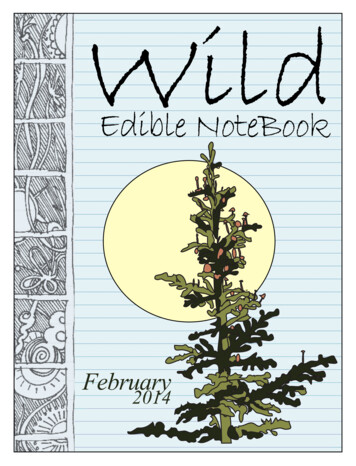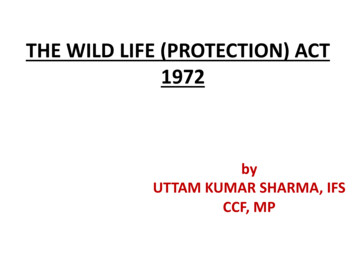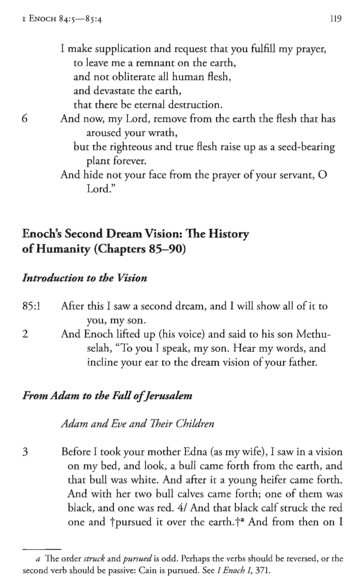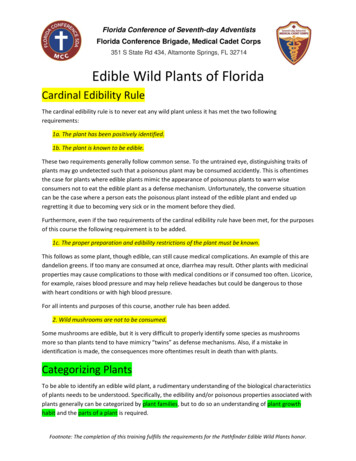
Transcription
Into the wildTechnology for open educational resourcesReflections on three years of the UK OER ProgrammeEdited by Amber Thomas, Lorna M. Campbell, Phil Barker andMartin Hawksey.
Into the Wild – Technology for Open Educational ResourcesEdited by Amber Thomas, Lorna M. Campbell, Phil Barker and Martin HawkseyCopyright 2012 University of Bolton unless otherwise stated.This work is licensed under the Creative CommonsAttribution 3.0 Unported License. To view a copy of thislicense, visit hed by University of Bolton, Deane Road, Bolton, BL3 5ABISBN: 978-0-907311-35-5 (print on demand)ISBN: 978-0-907311-36-2 (ebook, Kindle)ISBN: 978-0-907311-37-9 (ebook, ePub)ISBN: 978-0-907311-38-6 (ebook, pdf)URL: http://publications.cetis.ac.uk/2012/601
CONTENTSAbout the editors . viiAcknowledgements.ixForeword .xIntroducing the UK OER Programme .1Defining OER .14Resource Management .25Resource Description .36Licensing and Attribution .47SEO and discoverability .61Tracking OERs .68Paradata - activity data for learning resources .78Accessibility .86Conclusions .91Contributed comments and feedback .99
ABOUT THE EDITORSAmber ThomasAmber has worked in ICT in education for 14 years,working on JISC Information Strategies Initiative,Becta's National Grid for Learning, Becta's Ferl service,JISC-funded West Midlands Share Project at theUniversity of Worcester, then JISC and now in a servicemanagement role within Warwick University. Ambermanages the academic technologies team at theUniversity of Warwick, which includes responsibilityfor elearning tools advice, the VLE/LMS, coursework management, support fordigital humanities, and collaborating on research data management andacademic epublishing. Until late 2012 she worked at JISC www.jisc.ac.uk, whereshe focussed on digital infrastructure for learning materials, she had oversight ofJorum, the national repository www.jorum.ac.uk and and she was theprogramme manager leading the OER Rapid Innovation projects designed tomeet key use cases around open educational content.Lorna M. CampbellLorna has worked in education technology andinteroperability standards for fifteen years, and for thelast ten years has been an Assistant Director of theCentre for Educational Technology and InteroperabilityStandards (CETIS). During this time she has beenresponsible for coordinating and delivering technicalsupport for a wide range of JISC developmentprogrammes including the Exchange for LearningProgramme, the Digital Repositories and PreservationProgramme, the UK OER Programmes and the OER Rapid InnovationProgramme. She has also represented the UK Higher and Further Educationsector on a number of national and international standards bodies including theBritish Standards Institute, IMS Global, and CEN / ISSS Learning Technologiesvii
Workshop. Her areas of expertise include learning resource description andmanagement and digital infrastructure for open educational resources.Phil BarkerPhil has worked supporting the use of learningtechnology at Universities for eighteen years, andworked with CETIS in some facility for the last ten. AtCETIS he has been responsible for delivering support toJISC funded projects in areas such as metadata,resource description, resource management and openeducational resources. He has represented UK Higherand Further Education in a number of technicalspecification and standardization initiatives, mostrecently through the technical working group of theLearning Resource Metadata Initiative. He is a Research Fellow in the School ofMathematics and Computer Sciences at Heriot-Watt University, where his mainareas of work concern resource description and management, open educationalresources (OERs) and the evaluation of computer based resources forengineering and physical science education.Martin HawkseyMartin has worked in educational technology for twelveyears and has worked with the Centre for EducationalTechnology and Interoperability Standards (CETIS) forthe last year. At CETIS he has mainly been involved inthe UK OER Programme providing technical supportand guidance. Some of this work has included theextraction and visualisation of data generated as part ofUK OER. His areas of expertise include web application and 'mashup'development, data mining and harvesting techniques as well as extracting socialactivity data from 3rd party services.viii
ACKNOWLEDGEMENTSThere are many people whom the editors wish to thank for help and support inwriting this book and the work that lead to it; too many for us to list them allindividually. However, some deserve to be singled out. Firstly, Adam Hyde ofSourceFabric who first introduced us to the idea of a book sprint and throughwhose able facilitation our book sprint was enjoyable and productive. WithoutAdam's interventions it is doubtful whether this book would exist. R. JohnRobertson is in some ways the missing member of the editorial team, he workedwith CETIS supporting the OER Programmes until early 2012 and left behind awealth of material on which we drew for several chapters. For this we thank him.We also wish to thank Terry McAndrew, of JISC TechDis for stepping in to fill agap in our knowledge and writing the chapter on accessibility, and Lynne Stuartour graphic designer and illustrator. Likewise also thanks to all who worked onUK OER Programme projects and support services, particularly David Kernohanfor leading JISC input into the OER Progamme, Lou McGill and Helen Beethamfor their work on Programme synthesis and evaluation and Naomi Korn for legalguidance. We thank those who contributed the commentary and opinions thataccompany this book.We are grateful to JISC for their financial support for the book sprint and fortheir understanding in allowing us to experiment with this approach to synthesisand writing. We also thank them, along with the HE Academy and HEFCE forsupporting and funding the OER Programmes over three years.ix
FOREWORDBetween 2009 and 2012 the UK Higher Education Funding Council funded aseries of programmes to encourage higher education institutions in the UK torelease existing educational content as Open Educational Resources1. TheHEFCE funded UK OER Programme was run and managed by the JISC and theHigher Education Academy. The JISC CETIS "OER Technology SupportProject"2 provided support for technical innovation across this programme. Thisbook synthesises and reflects on the approaches taken and lessons learnt acrossthe Programme and by the Support Project. The Higher Education Funding Council for England, (HEFCE)3 distributespublic money for higher education to universities and colleges in England,and ensures that this money is used to deliver the greatest benefit tostudents and the wider public. The Joint Information Systems Committee (JISC)4 supports higher andfurther education by providing strategic guidance, advice and opportunitiesto use information and communications technology (ICT) to supportresearch, teaching, learning and administration. JISC is funded by all theUK post-16 and higher education funding councils. The Higher Education Academy (HEA)5 works with universities andcolleges, discipline groups, individual staff and organisations to help themdeliver the best possible learning experience for students. The Centre for Educational Technology and Interoperability Standards(CETIS)6 are globally recognised as leading experts on interoperability andtechnology standards in learning, education and training. They work withclients and partners to develop policy and strategy, providing impartial andindependent advice on technology and standards across a wide rangeeducational issues including open educational resources.This book is not intended as a beginners guide or a technical manual, insteadit is an expert synthesis of the key technical issues arising from a nationalpublicly-funded programme. It is intended for people working with technologyto support the creation, management, dissemination and tracking of openeducational resources, and particularly those who design digital infrastructureand services at institutional and national level.The book is the result of a two and a half day writing session facilitated byAdam Hyde of Booksprint7.x
References1. JISC / HEA Open Educational Resources Programmes, http://www.jisc.ac.uk/oer2. JISC CETIS OER Technical Support Project Team: Dr Phil Barker, Ms Lorna M. Campbell,Mr Martin Hawksey and Mr R. John Robertson.3. HEFCE, http://www.hefce.ac.uk/4. JISC, www.jisc.ac.uk5. HEA, http://www.heacademy.ac.uk/6. CETIS, http://jisc.cetis.ac.uk/7. Booksprints.net, http://www.booksprints.net/8. CC BY 3.0, http://creativecommons.org/licenses/by/3.0/xi
INTRODUCING THE UK OERPROGRAMMEThe UK OER Programme1 was run by the UK Higher Education Academy andJISC, with funding from HEFCE, between 2009 and 2012. The Programme builton previous work undertaken by JISC, and the expertise of the JISC CETISInnovation Support Centre. This book explores the technical issues surfaced bythe programme and the JISC CETIS OER Technical Support Project during thisthree year period.JISC Programmes 2002-2009JISC has a long history in developing and promoting innovative technicalapproaches to learning resource management and discovery that can be tracedback to programmes such as Exchange for Learning2 (X4L, 2002–2006), whichfocused on the creation of reusable learning resources, and tools to facilitate theirproduction and management; Re-purposing and Re-use of Digital Universitylevel Content3 (RePRODUCE, 2008–2009) which encouraged the re-use of highquality externally produced materials and facilitated the transfer of learningcontent between institutions; and the Digital Repositories4 (2005–2007) andRepositories Preservation Programmes5 (2006–2009) which aimed to establishtechnical infrastructure within institutions and across the sector. (For anoverview of learning technology initiatives funded by various bodies across UKeducational sectors prior to 2002, see Open Educational Resources – a historicaland international perspective by David Kernohan and Amber Thomas, 20126).These programmes were informed by a strategic and technical vision that wasexpressed through initiatives including the e-Learning Framework7, the eFramework8, the Information Environment Technical Architecture9 and theDigital Repositories Roadmap10. The Information Environment Architecture forexample sought to “specify a set of standards and protocols intended to supportthe development and delivery of an integrated set of networked services thatallowed the end-user to discover, access, use and publish digital and physicalresources as part of their learning and research activities.”11For example the aims of the 2002 Exchange for Learning (X4L) Programmewere to:1
Introducing the UK OER Programme“use and develop the best available tools to explore whether repurposingcontent can become a popular, sustainable way of producing e-learningmaterials for the future; increase the numbers of people in institutions with the necessary skills torepurpose learning objects; expose and begin to tackle the challenges associated with repurposinglearning objects; and begin to populate a national repository with learning materials as well ascase studies and exemplars showing how these have been achieved.”12In order to achieve these aims the programme gave projects a strong steer touse educational technology interoperability standards such as IMS QTI13, IMSContent Packaging14, ADL SCORM15 and IEEE LOM16. CETIS developed amandatory application profile of the IEEE LOM for the programme and formalsubject classification vocabularies were identified including JACS17 and theDewey Decimal Classification System18. Projects were strongly recommended todeposit their content in the national Jorum repository19 (also developed as part ofthe X4L Programme), institutions were required to sign formal licenceagreements, and access to content deposited content in Jorum was restricted toUK F/HE institutions only.An OER timeline20 mapping these initiatives was created for JISC CETIS. 2
Introducing the UK OER ProgrammeFigure 1 OER Timeline produced by Lou McGill for CETIS Other Voices Blog 2012These early programmes and initiatives met with varying degrees of successacross the different sectors of the UK F/HE community. While the X4Lprogramme defined the way that JISC and partners would deliver programmesaimed at systemic cultural change, the programme evaluation was clear thatsignificant barriers around the online sharing and reuse of educational resourcesremained:“X4L has demonstrated that the principal benefits of reuse andrepurposing are generally understood and accepted in thecommunities involved in the programme. However, the concept ofreusable learning objects is still not proven or generally accepted inmainstream practice across the FE and HE sectors. That said, X4Lhas identified and explored many of the key barriers to reuse andrepurposing, including the pressures of time and resource constraintson staff, concerns about professional integrity and academicindependence, cultural resistance to sharing, and tensions betweencommunity collaboration and institutional competition.”213
Introducing the UK OER ProgrammeIn addition, while there has been considerable progress since 2000 indeveloping open access institutional repositories and promoting the deposit ofscholarly works, journal papers and e-theses22 ; there was arguably less success inusing repositories to support and facilitate access to teaching and learningmaterials. Indeed one of the final conclusions of the 2006 - 2009 Repositories andPreservation Programme Advisory Group, which advised the JISC repositoriesprogrammes, was that teaching and learning resources had not been served wellby the debate about institutional repositories seeking to cover both open accessto research outputs and management of teaching and learning materials as theissues relating to their use and management are fundamentally different.Furthermore, in 2009 the findings of the RePRODUCE Programme suggestedthat projects had significantly underestimated the difficulty of finding highquality teaching and learning materials that were suitable for copyright clearanceand reuse.From 2006 onwards, JISC CETIS was tasked with providing the technicalframework and guidelines for programmes and initiatives within the e-learningdomain. This involved the identification of systems, technologies, open standardsand vocabularies that programmes mandated and projects were required toimplement.Evolution of OERThe term Open Educational Resources (OER) was first introduced at aconference hosted by UNESCO in 200223 and was promoted in the context ofproviding free access to educational resources on a global scale. There are manysubtly varying definitions of OER, however on a basic level open educationalresources may be described as freely available digital materials released underopen licence, that can be used and re-purposed for teaching, learning, andresearch.In 2001, while JISC were scoping the X4L Programme, the Hewlett foundationwere supporting MIT in launching the OpenCourseWare (OCW) movementwhich proposed to make almost all of its 2,000 courses, in the form of lecturenotes, problem sets, syllabuses, exams, simulations and video lectures, freelyavailable to the general public on the open web. Faculty chairman Steve Lermantold the New York Times:“Selling content for profit, or trying in some ways to commercializeone of the core intellectual activities of the university [.] seemed less4
Introducing the UK OER Programmeattractive to people at a deep level than finding ways to disseminateit as broadly as possible.”24This position was amplified by the then MIT President, Professor CharlesVest:“This is a natural fit to what the Web is really all about, [.] We'velearned this lesson over and over again. You can't have tight, closedup systems. We've tried to open up software infrastructure in avariety of ways and that's what unleashed the creativity of softwaredevelopers; I think the same thing can happen in education.”That same year, the Center for the Public Domain25 provided support forCreative Commons, a new nonprofit organization that set out to enable thesharing and use of creativity and knowledge through free legal tools. InDecember 2002 Creative Commons launched their first set of free copyrightlicenses26. These copyright licenses provided a simple, standardized way to allowthe public permission to share and use creative works.Three years later in 2005 the Open CourseWare Consortium (OCWC)27 wasfounded with the support of the William and Flora Hewlett foundation28.OCWC drew together a number of other institutions that had followed the MITOCWC model. Early members included many North American institutions, butalso consortia from China and Japan.The first large scale OER initiatives in the UK were launched in 2006 and 2007respectively. In October 2006 the Open University launched OpenLearn29, whichaimed to make a selection of OU materials available worldwide for free use andto build communities of learners and educators around the content using a rangeof tools and strategies. OpenLearn provided not only a collection of free coursematerial but also a set of tools to help authors publish and support collaborativelearning communities.In September 2007 the University of Nottingham developed U-Now30 acollection of open educational materials openly licensed for anyone to use. Thesematerials ranged from complete modules to smaller-scale learning objectives,and highlighted a range of teaching and learning activities from across theinstitution.The following year in 2008, CETIS published a whitepaper on global OERdevelopments, Open Educational Resources – Opportunities and Challenges forHigher Education31. This influential paper covered current and future trends in5
Introducing the UK OER ProgrammeOER development and aimed to stimulate debate and develop a forward lookingresearch agenda. Topics covered included a discussion of the conceptual andcontextual issues of open educational resources, a review of current OERinitiatives, and discussion of emerging trends, with respect to future research andactivities.At the same time JISC had also commissioned a report on improving theevidence base in support of sharing learning materials. The Good Intentionsreport32 articulated the advantages and imperatives for sharing learning resourcesusing evidence from the UK and elsewhere. It also identified a number ofcompelling business cases and developed a set of variations as a result of studyinga range of business models.The UK OER ProgrammeThere were three phases to the UK OER Programme, described collectively hereas the Programme. Each phase was planned in response to emerging prioritiesfrom the projects, so it shifted its focus over time.Figure 2 Three years of UKOER , David Kernohan, JISC 20126
Introducing the UK OER ProgrammeOER Phase 1 Pilot ProgrammeIn response to these global developments and national education policy driversacross the UK, HEFCE provided 5.7 million to JISC and the Higher EducationAcademy in 2009 to launch the first UK Open Educational ResourcesProgramme33. This Pilot Programme, one of the first national OER initiatives inthe world, ran from April 2009 to April 2010 and funded projects to make asignificant amount of existing learning resources freely available online, licensedin such a way to enable them to be used and repurposed worldwide. Themetaphor commonly used while the programme was being scoped was of"turning on the tap" to get the largest volume of open educational resources outinto the public domain. In addition to simply releasing resources, projects werealso expected to demonstrate a long term commitment to the release of openeducational resources (OER) and to work towards the sustainability of long termopen educational resource release via the adoption of appropriate businessmodels. Where possible, projects were encouraged to work towards themodification of institutional policies and processes, with the aim of making OERrelease an expected part of the educational resources creation cycle. Funding wasallocated to 29 individual, institutional and subject focused projects.UK OER technical guidanceAs a part of the UK OER Pilot Programme, JISC also provided support, adviceand guidance on all aspects of open educational resource production anddissemination. This included guidance on issues around licensing andintellectual property rights, technology and standards.In keeping with the experimental nature of the Pilot Programme, and incontrast to previous content creation programmes which mandated the use ofspecific technologies and standards, CETIS recommended that JISC adopt an"anything goes" approach to the programme. Rather than identifying specificapplications, technical models, standards, application profiles and vocabularies,CETIS advocated that the OER Pilot Programme should adopt an open approachto the use of technology and standards34. Projects were allowed to release anykind of content, in any format, anywhere. Although projects were encouraged touse open standards where possible, proprietary formats were also acceptable.CETIS advised projects on the type of information they should record about theirresources (e.g. title, author, owner, contributor, date, URL, file format, name andsize) but not how to go about recording it. There was no programme specific7
Introducing the UK OER Programmemetadata application profile and no formal metadata standard or vocabularieswere recommended. The only mandatory metadata that projects were directed torecord was the programme tag: ukoer. Projects were also given free rein to useany dissemination platform they chose provided that the content was freelyavailable and released under an open licence. In addition, projects also had torepresent their resources in JorumOpen either by linking or through directdeposit with all resources represented in JorumOpen being freely availableworldwide and released under Creative Commons licences.Rather than a radical shift in policy, this approach to technology andstandards should be regarded as a reflection of a gradual development in policy,licensing and technology right across the web. These developments are illustratedby the advent of the social web, the appearance of media specific disseminationplatforms such as slideshare, YouTube, flickr, iTunesU, interaction throughRESTful APIs, OpenID, OAuth and other web-wide technologies, along withincreasing acceptance of Creative Commons licenses. As a result, there had beena movement away from the development of centralised education specific toolsand services, and towards the integration of institutional systems withapplications and services scattered across the web. Furthermore, there wasgrowing awareness of the importance of the web itself as a technical architectureas opposed to a simple interface or delivery platform.It was hoped that this approach would also provide an opportunity forauthentic technical practice to emerge and for pertinent technology issues andproblem areas to surface. This open approach to technology and standards andsupporting technical diversity generated considerable interest from agenciesoutwith the UK including as ADL35 and OCWC.In 2010 and 2011 HEFCE released funding for two further phases of the UKOER Programme and this open approach to systems, technology and standardswas deemed to be sufficiently successful to underpin these new programmes.OER Phase 2 ProgrammeThe 5 million OER Phase 2 Programme which ran from August 2010 to August2011 focused on three activity areas: release, use and discovery of OER36. 23individual projects were funded and additional reports were commissioned on arange of topics including: patterns of behaviour around the use and reuse of OERand the impact of these behaviours on teaching and learning strategies frominstitutional, tutor and student perspectives; reflective case studies into the wayopen educational resources are used in a variety of contexts, including seminars,8
Introducing the UK OER Programmelectures and virtual learning environments; and tracking the use of materialsreleased by pilot phase projects. The six "collections" projects were of particularinterest as they aimed to use innovative technology approaches to bring togetherdynamic thematic collections of open educational resources from a range ofsources worldwide.Technical Mini Projects and Data Analysis and Visualisation ProjectUnderpinning the main funded programme, JISC were also focusing on widerdigital infrastructure directions to support open educational resources andidentifying specific technical interventions for potential funding. In this contexta series of additional small projects were commissioned through CETIS toexplore specific technical issues. These included the OER Technical MiniProjects, awarded to the University of Newcastle in the UK (OERBookmarking)37 and MIT in the US (CaPRéT - Cut and Paste Reuse Tracking)38,and the innovative OER data analysis and visualisation project39. Thevisualisation project was successful in documenting workflows for extractingdata using different techniques including consuming linked data in GoogleSpreadsheets and harvesting OAI-PMH records using Google Refine. Outputsalso included methods for cleaning data and reconciling it with other datasets.This included resolving tracking data from the CaPRéT OER Technical MiniProject and examining social share statics of Jorum ‘ukoer’ records.OER Phase 3 ProgrammeThe third phase of the OER Programme which ran from October 2011 toOctober 2012 covered a variety of themes and produced a wide range ofoutputs40. Themes included the use of OER approaches to work towardsparticular strategic, policy and societal goals; support for institutional change;and the evolution of institutional policy to the support of the use, developmentand cultural acceptance of OER as part of everyday educational practice.Rapid InnovationBuilding on the experience of the CETIS Technical Mini-Projects, JISC alsoidentified a number of areas where there were opportunities to enhance thedigital infrastructure to support open content in education by funding smallshort projects producing technical solutions41.9
Introducing the UK OER ProgrammeFigure 3 Thomas, A., (2011). Wordcloud of the Call for OER Rapid Innovation Projects, produced usingwordle.netAn open call for project based at Universities and Colleges was launched and15 short technical rapid innovation projects were funded, covering issues asdiverse as linked data infrastructure for OER, sharing paradata across widgetstores, increasing OER discoverability by improving keyword metadata viaautomatic speech to text transcription and the use of BuddyPress as aninstitutional academic profile management tool42.Sister Content ProgrammeAnother JISC programme which approached OER from a somewhat differentangle was the 5.4 million Content Programme, running from 2011 - 2013. Thisprogramme funded 23 projects in three different strands focusing on massdigitisation, clustering of existing digital content and digitisation for openeducational resources. The aim of the digitisation for OER strand43 is to releasedigitised educational content suitably licensed for use and re-use on an openaccess basis, and embed it within teaching and learning. Projects wereencouraged to place particular emphasis on innovative approaches to thecreation and delivery of digital content by working in partnership within andoutside the educational sector to maximising the reach and impact of the contentcreated.10
Introducing the UK OER ProgrammeJISC CETIS UK OER Technical Support ProjectFigure 4 Thomas, A (2009) Technical Focus of the UK OER Programme DiagramIn scoping the OER Programme it became apparent that the biggest technicalchallenges would be in the way that content was made available on the web.Whilst it sounds obvious how an OER creator can just "put it online", there aremany choices to be made if release is to contribute to a healthy ecosystem ofopen content. In describing these issues, the authors of this book used theanalogy of releasing OERs "into the wild" to express the mindset required tounderstand this evolving space.The following chapters focus on technical issues that the UK OER Programmesurfaced in this space, explores their relevance, the approach the Programmetook, and where possible, the authors look to future directions.11
Introducing the UK OER ProgrammeReferences1. JISC / HEA Open Educational Resources Programmes, http://www.jisc.ac.uk/oer2. JISC Exchange for Learning /x4l.aspx3. Re-purposing and Re-use of Digital University-level Content Programme, s/elearningcapital/reproduce.aspx4. Digital Repositories s/digitalrepositories2005.aspx5. Repositories Preservation s/reppres.aspx6. Repositories Preservation Programmeshttp:
Into the wild Technology for open educational resources . There are many people whom the editors wish to thank for help and support in . wealth of material on which we drew for several chapters. For this we thank him. We also wish to thank Terry McAndrew, of JI








![INDEX [randycherry ]](/img/21/x-20-20tv-20fakebook-20-20hal-20leonard.jpg)


